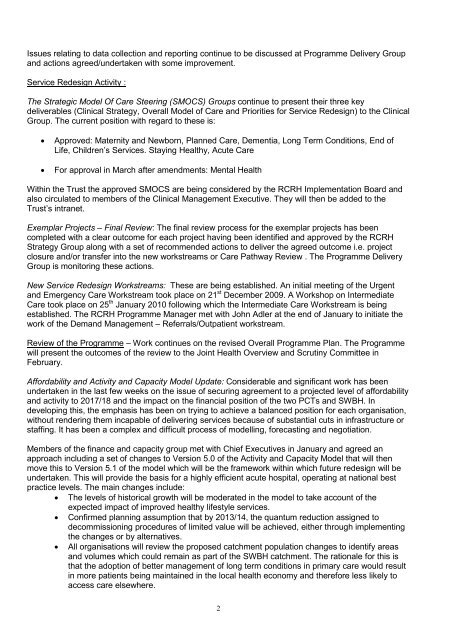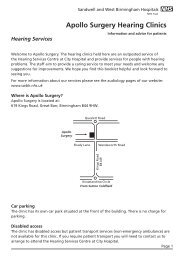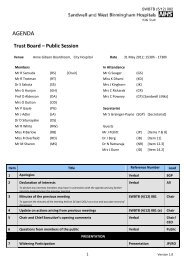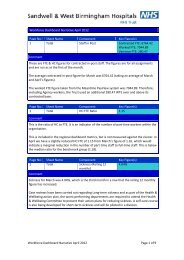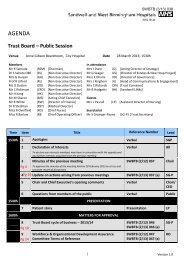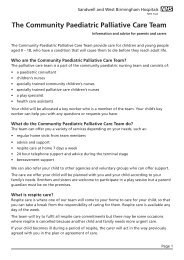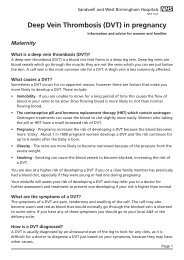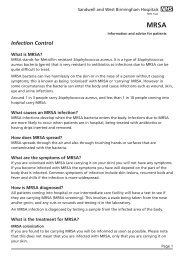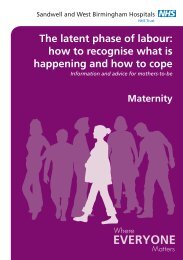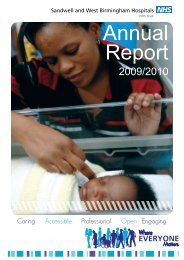Trust Board Febuary 2010 - Sandwell & West Birmingham Hospitals
Trust Board Febuary 2010 - Sandwell & West Birmingham Hospitals
Trust Board Febuary 2010 - Sandwell & West Birmingham Hospitals
You also want an ePaper? Increase the reach of your titles
YUMPU automatically turns print PDFs into web optimized ePapers that Google loves.
Issues relating to data collection and reporting continue to be discussed at Programme Delivery Group<br />
and actions agreed/undertaken with some improvement.<br />
Service Redesign Activity :<br />
The Strategic Model Of Care Steering (SMOCS) Groups continue to present their three key<br />
deliverables (Clinical Strategy, Overall Model of Care and Priorities for Service Redesign) to the Clinical<br />
Group. The current position with regard to these is:<br />
• Approved: Maternity and Newborn, Planned Care, Dementia, Long Term Conditions, End of<br />
Life, Children’s Services. Staying Healthy, Acute Care<br />
• For approval in March after amendments: Mental Health<br />
Within the <strong>Trust</strong> the approved SMOCS are being considered by the RCRH Implementation <strong>Board</strong> and<br />
also circulated to members of the Clinical Management Executive. They will then be added to the<br />
<strong>Trust</strong>’s intranet.<br />
Exemplar Projects – Final Review: The final review process for the exemplar projects has been<br />
completed with a clear outcome for each project having been identified and approved by the RCRH<br />
Strategy Group along with a set of recommended actions to deliver the agreed outcome i.e. project<br />
closure and/or transfer into the new workstreams or Care Pathway Review . The Programme Delivery<br />
Group is monitoring these actions.<br />
New Service Redesign Workstreams: These are being established. An initial meeting of the Urgent<br />
and Emergency Care Workstream took place on 21 st December 2009. A Workshop on Intermediate<br />
Care took place on 25 th January <strong>2010</strong> following which the Intermediate Care Workstream is being<br />
established. The RCRH Programme Manager met with John Adler at the end of January to initiate the<br />
work of the Demand Management – Referrals/Outpatient workstream.<br />
Review of the Programme – Work continues on the revised Overall Programme Plan. The Programme<br />
will present the outcomes of the review to the Joint Health Overview and Scrutiny Committee in<br />
February.<br />
Affordability and Activity and Capacity Model Update: Considerable and significant work has been<br />
undertaken in the last few weeks on the issue of securing agreement to a projected level of affordability<br />
and activity to 2017/18 and the impact on the financial position of the two PCTs and SWBH. In<br />
developing this, the emphasis has been on trying to achieve a balanced position for each organisation,<br />
without rendering them incapable of delivering services because of substantial cuts in infrastructure or<br />
staffing. It has been a complex and difficult process of modelling, forecasting and negotiation.<br />
Members of the finance and capacity group met with Chief Executives in January and agreed an<br />
approach including a set of changes to Version 5.0 of the Activity and Capacity Model that will then<br />
move this to Version 5.1 of the model which will be the framework within which future redesign will be<br />
undertaken. This will provide the basis for a highly efficient acute hospital, operating at national best<br />
practice levels. The main changes include:<br />
• The levels of historical growth will be moderated in the model to take account of the<br />
expected impact of improved healthy lifestyle services.<br />
• Confirmed planning assumption that by 2013/14, the quantum reduction assigned to<br />
decommissioning procedures of limited value will be achieved, either through implementing<br />
the changes or by alternatives.<br />
• All organisations will review the proposed catchment population changes to identify areas<br />
and volumes which could remain as part of the SWBH catchment. The rationale for this is<br />
that the adoption of better management of long term conditions in primary care would result<br />
in more patients being maintained in the local health economy and therefore less likely to<br />
access care elsewhere.<br />
2


